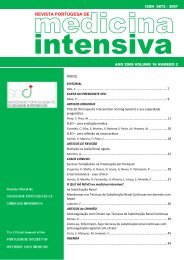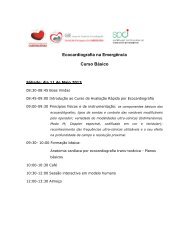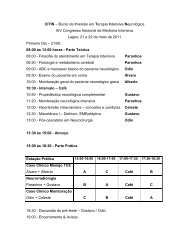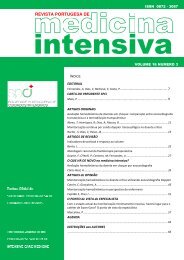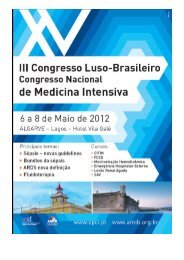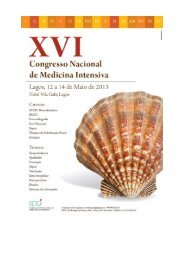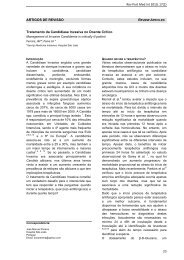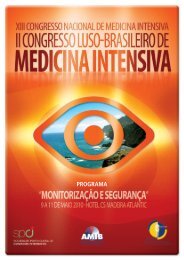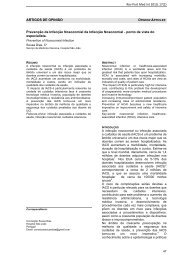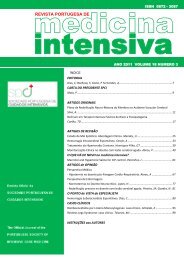Março de 2011 - Vol 18 numero 1 - Sociedade Portuguesa de ...
Março de 2011 - Vol 18 numero 1 - Sociedade Portuguesa de ...
Março de 2011 - Vol 18 numero 1 - Sociedade Portuguesa de ...
Create successful ePaper yourself
Turn your PDF publications into a flip-book with our unique Google optimized e-Paper software.
Bibliografia<br />
81<br />
69. Perkins GD, Stephenson B, Hulme J, Monsieurs KG. Birmingham assessment<br />
of breathing study (BABS). Resuscitation 2005;64:109-13.<br />
70. Bobrow BJ, Zuercher M, Ewy GA, et al. Gasping during cardiac arrest<br />
in humans is frequent and associated with improved survival. Circulation<br />
2008;1<strong>18</strong>:2550-4.<br />
71. Taylor RB, Brown CG, Bridges T, Werman HA, Ashton J, Hamlin RL. A<br />
mo<strong>de</strong>l for regional blood flow measurements during cardiopulmonary<br />
resuscitation in a swine mo<strong>de</strong>l. Resuscitation 1988;16:107-<strong>18</strong>.<br />
72. Eftestol T, Sun<strong>de</strong> K, Steen PA. Effects of interrupting precordial compressions<br />
on the calculated probability of <strong>de</strong>fibrillation success during<br />
out-of-hospital cardiac arrest. Circulation 2002;105:2270-3.<br />
73. Auf<strong>de</strong>rhei<strong>de</strong> TP, Pirrallo RG, Yannopoulos D, et al. Incomplete chest<br />
wall <strong>de</strong>compression: a clinical evaluation of CPR performance by<br />
EMS personnel and assessment of alternative manual chest compression-<strong>de</strong>compression<br />
techniques. Resuscitation 2005;64:353-62.<br />
74. Yannopoulos D, McKnite S, Auf<strong>de</strong>rhei<strong>de</strong> TP, et al. Effects of incomplete<br />
chest wall <strong>de</strong>compression during cardiopulmonary resuscitation on<br />
coronary and cerebral perfusion pressures in a porcine mo<strong>de</strong>l of cardiac<br />
arrest. Resuscitation 2005;64:363-72.<br />
75. Ornato JP, Hallagan LF, McMahan SB, Peeples EH, Rostafinski AG.<br />
Attitu<strong>de</strong>s of BCLS instructors about mouth-to-mouth resuscitation during<br />
the AIDS epi<strong>de</strong>mic. Ann Emerg Med 1990;19:151-6.<br />
76. Hew P, Brenner B, Kaufman J. Reluctance of paramedics and emergency<br />
medical technicians to perform mouth-to-mouth resuscitation.<br />
J Emerg Med 1997;15:279-84.<br />
77. Chandra NC, Gruben KG, Tsitlik JE, et al. Observations of ventilation<br />
during resuscitation in a canine mo<strong>de</strong>l. Circulation 1994;90:3070-5.<br />
78. Kern KB, Hilwig RW, Berg RA, San<strong>de</strong>rs AB, Ewy GA. Importance of<br />
continuous chest compressions during cardiopulmonary resuscitation:<br />
improved outcome during a simulated single lay-rescuer scenario.<br />
Circulation 2002;105:645-9.<br />
79. Ged<strong>de</strong>s LA, Run<strong>de</strong>ll A, Otlewski M, Pargett M. How much lung ventilation is<br />
obtained with only chest-compression CPR? Cardiovasc Eng 2008;8:145-8.<br />
80. Berg RA, Kern KB, Hilwig RW, et al. Assisted ventilation does not improve<br />
outcome in a porcine mo<strong>de</strong>l of single-rescuer bystan<strong>de</strong>r cardiopulmonary<br />
resuscitation. Circulation 1997;95:1635-41.<br />
81. Berg RA, Kern KB, Hilwig RW, Ewy GA. Assisted ventilation during<br />
‚bystan<strong>de</strong>r‘ CPR in a swine acute myocardial infarction mo<strong>de</strong>l does<br />
not improve outcome. Circulation 1997;96:4364-71.<br />
82. Turner I, Turner S, Armstrong V. Does the compression to ventilation<br />
ratio affect the quality of CPR: a simulation study. Resuscitation<br />
2002;52:55-62.<br />
83. Dorph E, Wik L, Stromme TA, Eriksen M, Steen PA. Oxygen <strong>de</strong>livery<br />
and return of spontaneous circulation with ventilation:compression ratio<br />
2:30 versus chest compressions only CPR in pigs. Resuscitation<br />
2004;60:309-<strong>18</strong>.<br />
84. Bohm K, Rosenqvist M, Herlitz J, Hollenberg J, Svensson L. Survival<br />
is similar after standard treatment and chest compression only in<br />
out-of-hospital bystan<strong>de</strong>r cardiopulmonary resuscitation. Circulation<br />
2007;116:2908-12.<br />
85. Kitamura T, Iwami T, Kawamura T, et al. Conventional and chest-<br />
-compression-only cardiopulmonary resuscitation by bystan<strong>de</strong>rs for<br />
children who have out-of-hospital cardiac arrests: a prospective, nationwi<strong>de</strong>,<br />
population-based cohort study. Lancet 2010.<br />
86. Kitamura T, Iwami T, Kawamura T, Nagao K, Tanaka H, Hirai<strong>de</strong> A.<br />
Bystan<strong>de</strong>r- Initiated Rescue Breathing for Out-of-Hospital Cardiac<br />
Arrests of Noncardiac Origin. Circulation 2010;122:293-9.<br />
87. Peberdy MA, Ottingham LV, Groh WJ, et al. Adverse events associated<br />
with lay emergency response programs: the public access <strong>de</strong>fibrillation<br />
trial experience. Resuscitation 2006;70:59-65.<br />
88. Sugerman NT, E<strong>de</strong>lson DP, Leary M, et al. Rescuer fatigue during actual<br />
in-hospital cardiopulmonary resuscitation with audiovisual feedback:<br />
a prospective multicenter study. Resuscitation 2009;80:981-4.<br />
89. Hallstrom AP, Ornato JP, Weisfeldt M, et al. Public-access <strong>de</strong>fibrillation<br />
and survival after out-of-hospital cardiac arrest. N Engl J Med<br />
2004;351:637-46.<br />
90. Hoke RS, Heinroth K, Trappe HJ, Werdan K. Is external <strong>de</strong>fibrillation an<br />
electric threat for bystan<strong>de</strong>rs? Resuscitation 2009;80:395-401.<br />
91. Dickinson CL, Hall CR, Soar J. Acci<strong>de</strong>ntal shock to rescuer during successful<br />
<strong>de</strong>fibrillation of ventricular fibrillation--a case of human involuntary<br />
automaticity. Resuscitation 2008;76:489.<br />
92. Cydulka RK, Connor PJ, Myers TF, Pavza G, Parker M. Prevention of<br />
oral bacterial flora transmission by using mouth-to-mask ventilation<br />
during CPR. J Emerg Med 1991;9:317- 21.<br />
93. Blenkharn JI, Buckingham SE, Zi<strong>de</strong>man DA. Prevention of transmission of infection<br />
during mouth-to-mouth resuscitation. Resuscitation 1990;19:151-7.<br />
94. Turner S, Turner I, Chapman D, et al. A comparative study of the 1992 and<br />
1997 recovery positions for use in the UK. Resuscitation 1998;39:153-60.<br />
95. Handley AJ. Recovery Position. Resuscitation 1993;26:93-5.<br />
96. Anonymous. Gui<strong>de</strong>lines 2000 for Cardiopulmonary resuscitation and<br />
emergency cardiovascular care - An international consensus on<br />
science. Resuscitation 2000;46:1-447.<br />
97. Fingerhut LA, Cox CS, Warner M. International comparative analysis of<br />
injury mortality. Findings from the ICE on injury statistics. International<br />
Collaborative Effort on Injury Statistics. Adv Data 1998:1-20.<br />
98. White RD, Bunch TJ, Hankins DG. Evolution of a community-wi<strong>de</strong><br />
early <strong>de</strong>fibrillation programme experience over 13 years using police/fire<br />
personnel and paramedics as respon<strong>de</strong>rs. Resuscitation<br />
2005;65:279-83.<br />
99. Mosesso VN, Jr,, Davis EA, Auble TE, Paris PM, Yealy DM. Use of<br />
automated external <strong>de</strong>fibrillators by police officers for treatment of<br />
out-of-hospital cardiac arrest. Ann Emerg Med 1998;32:200-7.<br />
100. The Public Access Defibrillation Trial Investigators. Public-access <strong>de</strong>fibrillation<br />
and survival after out-of-hospital cardiac arrest. N Engl J<br />
Med 2004;351:637-46.<br />
101. Kitamura T, Iwami T, Kawamura T, Nagao K, Tanaka H, Hirai<strong>de</strong> A.<br />
Nationwi<strong>de</strong> public-access <strong>de</strong>fibrillation in Japan. N Engl J Med<br />
2010;362:994-1004.<br />
102. Bardy GH, Lee KL, Mark DB, et al. Home use of automated external <strong>de</strong>fibrillators<br />
for sud<strong>de</strong>n cardiac arrest. N Engl J Med 2008;358:1793-804.<br />
103. Zafari AM, Zarter SK, Heggen V, et al. A program encouraging early<br />
<strong>de</strong>fibrillation results in improved in-hospital resuscitation efficacy. J<br />
Am Coll Cardiol 2004;44:846-52.<br />
104. Destro A, Marzaloni M, Sermasi S, Rossi F. Automatic external <strong>de</strong>fibrillators<br />
in the hospital as well? Resuscitation 1996;31:39-43.<br />
105. Spearpoint KG, Gruber PC, Brett SJ. Impact of the Immediate Life Support<br />
course on the inci<strong>de</strong>nce and outcome of in-hospital cardiac arrest calls:<br />
an observational study over 6 years. Resuscitation 2009;80:638-43.<br />
106. Cummins RO, Eisenberg MS, Litwin PE, Graves JR, Hearne TR, Hallstrom<br />
AP. Automatic external <strong>de</strong>fibrillators used by emergency medical<br />
technicians: a controlled clinical trial. JAMA 1987;257:1605-10.<br />
107. Stults KR, Brown DD, Kerber RE. Efficacy of an automated external<br />
<strong>de</strong>fibrillator in the management of out-of-hospital cardiac arrest: validation<br />
of the diagnostic algorithm and initial clinical experience in a<br />
rural environment. Circulation 1986;73:701-9.



